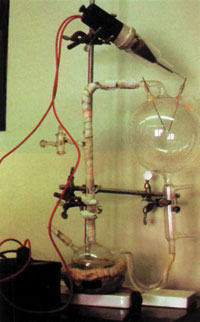Faced with the fact that amino acids could never have formed by chance under the conditions of the primeval Earth, evolutionists embarked on a search for some new way to account for the emergence of life. According to one of their new claims, a meteor fell to Earth. Soon after, organic substances and amino acids inside this meteor reacted together, and thus life sprang into being.
Yet it is now known that the primeval atmosphere was of such a kind that would have quickly broken down any amino acids. In addition, under the conditions of the primeval Earth, even if large quantities of amino acids had arrived from outer space, and even if the world had actually been awash in amino acids, this still would not account for the origin of living things. It would still have been impossible for amino acids to combine by chance and haphazardly give rise to exceedingly complex and three-dimensional proteins, the organelles of the cell, and then for these organelles to give rise to a cell with its own miraculous structure.
According to yet another view, the first life formed not on Earth, but on some other planet. These organisms were subsequently carried to Earth in the form of spores or seeds by meteors, and life thus began here. However, current knowledge shows that it is impossible for spores or seeds in the irradiated vacuum of space to have been withstood the heat, pressure, dangerous rays, etc. through their journey to Earth. Therefore, the claim that the first life formed on another planet does not resolve evolutionists’ problems at all, but merely places them one step back. The obstacles to life emerging by chance on Earth will also apply on any other planet.
 |
For their only evidence of this claim, evolutionists point to the Miller Experiment, carried out in 1953. Yet that experiment produced no living cell. All that happened was that a few simple amino acids were synthesized. But it is mathematically impossible for amino acids to assume the correct sequence and constitute proteins, and for these then to give rise to the cell, by chance. In addition, the amino acids that Miller synthesized were irrelevant and meaningless, because in his experiment Miller employed gasses that did not exist in the primeval Earth’s atmosphere.
Albumin, one of the proteins in the body, binds to itself fats such as cholesterol, hormones, toxic bile and drugs such as penicillin. It then travels throughout the body in the bloodstream, deposits the substances it has collected in the liver where they can be converted into usable form, and carries other nutrients and hormones to the sites where they are needed.
How can a molecule such as albumin, composed of unconscious, unknowing atoms, distinguish between fats, toxins, drugs and various nutrients?
Furthermore, how is it able to recognize the liver and gall bladder, and deposit the substances it transports at just the right place and in just the right amounts, never confusing them or making a mistake? Since it is impossible for human beings to tell toxins, nutrients and drugs carried in the bloodstream apart from one another, how is a molecule made up of atoms able to do so?
In our cells, the energy plants known as “mitochondria,” only 1/100 millimeters in size, are more complex than any oil refinery or hydroelectric station. Our cells, which possess no consciousness or knowledge and are made up of combinations of specific numbers of molecules, produce energy in a manner that is far more economical and practical than that devised by a combination of engineers, technical experts, workers and designers employing the most advanced technology.
Every detail in the energy plants in our cells has been flawlessly created, from energy conservation to the recycling of waste products. The theory of evolution is unable to account for the formation of even one of these features in the cell.
In a single human DNA molecule, there is sufficient information to fill one million printed pages. All this information has a very important sequence. Just think; if we typed millions of letters at random on sheets of paper, and if all these letters then turned into words and then formed an article like those in the pages of a newspaper, could we claim that this was all the result of blind chance? Of course not! Yet according to the Darwinist mindset, it is indeed possible for such an extraordinary event to take place by chance—not just once, but many times!
 |
Evolutionists ascribe the origin of different species’ different genetic characteristics to mutations—changes that, as you know, take place in DNA as a result of radiation or chemical effects. Yet these outside influences either damage DNA or else have no effects on it.
To clarify this with an example, let us record a very thorough history of the world on a computer. In the process, let us rewrite the book completely several times, and also ask the person typing it over to press the keyboard at random without actually looking at it. Could he improve this history book, or even complete it in the first place? Could a chapter titled “The History of Ancient Egypt” that did not already exist in ever come into being? The inevitable spelling mistakes can of course never improve or develop the book. On the contrary, they will impair it and damage its meaning. Yet evolutionists claim that, in effect, spelling mistakes can improve a book, making it more precise and sophisticated.
Certain genes have the ability to control others. For example, some “control” genes halt the gene that manufactures haemoglobin during childhood.
This fact requires careful reflection. Since genes are made up of molecules, how did these molecules set up such an organization among themselves? How can a molecule decide to halt a human being’s growth and to transmit that decision to others, and how do those other molecules understand that signal and act upon it? From whom did those disciplined orders originate?
Moreover, trillions of genes have been flawlessly performing these functions with the same discipline, obedience, reason and apparent intent for millions of years. To claim that such an immaculate system came into being by chance is utterly nonsensical.
 |
Let evolutionists place large quantities of elements found in the structure of living things—such as phosphorus, nitrogen, carbon, oxygen, iron and magnesium—into a large container. Let them also add whatever other materials not actually present under normal conditions, but which they may deem necessary. Let them also mix in as much amino acids (which cannot form spontaneously in the Earth’s atmosphere) and as many proteins (even though not a single protein can form by chance) as they wish.
To this mixture, let them apply as much heat and moisture as they desire. Then let them agitate it with whatever advanced equipment they choose. Let them have teams of eminent scientists stand watch over the container for billions or even trillions of years. Let them be free to apply whatever conditions they may believe to be necessary in order for life to form. No matter what they do they will definitely never be able to produce a living organism from it, much less a human being. They will definitely be unable to produce any of the countless living species on Earth, such as giraffes, lions, bees, canaries, nightingales, parrots, horses, dolphins, roses, orchids, irises, carnations, bananas, oranges, apples, dates, tomatoes, melons, water melons, figs, olives, grapes, peaches, peacocks, leeches or brightly-colored butterflies. They will be unable to produce even a single cell, let alone any one of these many life forms.
In short, unconscious, insentient atoms cannot combine together to form a cell. Neither can they subsequently decide to divide that cell into two, and then take further decisions and create creative humans who invent the electron microscope and then examine the structure of their own cells under it. Matter is an inanimate, unconscious substance, and finds life only through God’s sublime inspiration.
The theory of evolution, on the other hand, which maintains the exact opposite, is merely nonsense. Just a little consideration of about the irrational claims made by evolutionists will make this crystal clear.
If you see an ink stain on a piece of paper, you naturally assume that an ink has been spilled on the paper, forming a random shape. But should you see handwriting on that same paper that reads, “Call your father,” you can safely assume that this has not appeared haphazardly. Even if the writer of the note is not in the room, you know that this is a meaningful, purposeful message written by a conscious individual.
Alternatively, when you see a beautiful picture, you know that this is the product of a skilled and knowledgeable intelligent artist, even if you cannot actually see the artist who painted it.
 |
You never imagine that this picture has come into being through paints being flung at it at random. The same applies to the flawless features in living things. Their immaculate and extraordinary engineering clearly show that they cannot be the work of chance, but are rather the product of a Superior Creator. In the face of this truth, the theory of evolution is now in a state of collapse. The superior creation in living things is the work of God, the Lord of all the worlds.
The intricate complexity of anatomical systems makes the stage-by-stage development espoused by evolutionists completely impossible. For example, it is impossible for organs such as the tear gland, retina or iris, some of the components of the eye, to have formed separately, in gradual stages. Eyesight can take place only after all the components of the eyeball are present and fully functioning. If even one is missing or deficient, eye will be useless. And, according to the theory of evolution, any functionless organ should be eliminated by way of “natural selection.”
 |